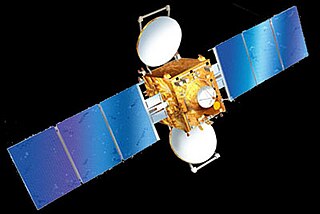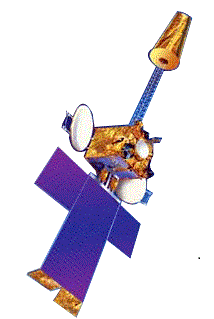| Mission type | Communications |
|---|---|
| Operator | Intelsat |
| COSPAR ID | 1995-023A [1] |
| SATCAT no. | 23571 |
| Mission duration | 15 years design life |
| Spacecraft properties | |
| Bus | SSL-1300 |
| Manufacturer | Space Systems/Loral |
| Launch mass | 4,180 kilograms (9,220 lb) |
| Dry mass | 1,450 kilograms (3,200 lb) |
| Dimensions | 2.7 by 2.2 by 2.45 metres (8.9 ft × 7.2 ft × 8.0 ft) |
| Start of mission | |
| Launch date | 17 May 1995, 06:34 UTC [2] |
| Rocket | Ariane 44 LP H10-3 |
| Launch site | Kourou ELA-2 |
| End of mission | |
| Disposal | Decommissioned |
| Deactivated | November 2014 |
| Orbital parameters | |
| Reference system | Geocentric |
| Regime | Geostationary |
| Longitude | 157° E |
| Perigee altitude | 36,126 kilometres (22,448 mi) [3] |
| Apogee altitude | 36,138 kilometres (22,455 mi) [3] |
| Inclination | 4.36° [3] |
| Period | 1,454.0 minutes [4] |
| Epoch | April 27, 2017 [4] [3] |
| Transponders | |
| Band | 26 C band 14 Ku band |
Intelsat VII | |
Intelsat 706 (also known as IS-706 and Intelsat 7-F6) is a geostationary communication satellite that was built by Space Systems/Loral (SSL). It is located in the orbital position of 157 degrees east longitude and it is currently in an inclined orbit. The same is owned by Intelsat. The satellite was based on the LS-1300 platform and its estimated useful life was 15 years. [5]
The satellite was successfully launched into space on May 17, 1995, [5] at 06:34, using an Ariane 4 vehicle from the Guiana Space Centre, Kourou, French Guiana. [5] It had a launch mass of 4,180 kg.
The Intelsat 706 is equipped with 26 transponders in C band and 10 in Ku band to provide broadcasting, business-to-home services and telecommunications. It was positioned over the Atlantic Ocean and has the transponder capacity to relay 110,000 telephone calls simultaneously. [6]
Polarization: circular R/L

The Indian National Satellite System or INSAT, is a series of multipurpose geostationary satellites launched by ISRO to satisfy the telecommunications, broadcasting, meteorology, and search and rescue operations. Commissioned in 1983, INSAT is the largest domestic communication system in the Indo-Pacific Region. It is a joint venture of the Department of Space, Department of Telecommunications, India Meteorological Department, All India Radio and Doordarshan. The overall coordination and management of INSAT system rests with the Secretary-level INSAT Coordination Committee.
NSS-6 is a communications satellite owned by SES WORLD SKIES.
KazSat 1, the first Kazakh space satellite, was launched on June 18, 2006 by Proton-K rocket. Containing 12 Ku-band transponders, KazSat was a communications satellite planned to occupy a geosynchronous orbit approximately 36,000km above the Earth. It was produced by Khrunichev Space Center in cooperation with Thales Alenia Space. Partial control of the satellite was lost in July 2008 and completely in October 2008.
Türksat 2A, a.k.a. Eurasiasat 1, was a Turkish communications satellite as part of a project to form an instant network with two geosynchronous satellites that is supervised by the companies Türksat A.Ş. in Turkey and Eurasiasat SAM in Monaco.
Intelsat 15, also known as IS-15, is a communications satellite owned by Intelsat. Intelsat 15 was built by Orbital Sciences Corporation, on a Star-2.4. It is located at 85° E longitude on the geostationary orbit. It was launched from Baikonur Cosmodrome to a geosynchronous transfer orbit on 30 November 2009 by a Zenit-3SLB launch vehicle. It has 22 active Ku band transponders, plus eight spares. Five of those transponders are owned and operated by SKY Perfect JSAT Group under the name JCSAT-85.

INSAT 3E is a defunct communication satellite built by Indian Space Research Organisation. It was launched on September 28, 2003 from the European Space Agency's spaceport in French Guiana on board the Ariane rocket. The satellite had a launch mass of 2750 kilograms. It is the 4th satellite launched in the INSAT-3 series for INSAT. It was designed for providing high-speed communication, Television, VSAT & Tele-education services and was an important landmark in Indian Space Programme.

INSAT-3A, a multipurpose satellite built by ISRO was launched by Ariane in April 2003. It is located at 93.5 degree East longitude. It is third satellite in INSAT-3 series after INSAT-3B & INSAT-3C. Built at a cost of $53 mn, it provides communication, weather, and search and rescue services.

Intelsat 901 (IS-901) was the first of nine new Intelsat satellites launched in June 2001 at 342°E, providing Ku-band spot beam coverage for Europe and C-band coverage for the Atlantic Ocean region. It is capable of selectable split uplink for SNG, tailored for increased communications demands such as DTH and Internet.
Intelsat 26 was known as JCSAT-5 before launch and as JCSAT-R until it was sold to Intelsat in 2009. It is a geostationary communications satellite designed and manufactured by Hughes on the HS-601 platform. It was originally ordered by JSAT Corporation, which later merged into the SKY Perfect JSAT Group. It has a mixed Ku band and C band payload and was used as an on orbit spare.
Intelsat 33e, also known as IS-33e, is a high throughput geostationary communications satellite operated by Intelsat and designed and manufactured by Boeing on the BSS-702MP platform. It is the second satellite of the EpicNG service, and will cover Europe, Africa and most of Asia from the 60°East longitude, where it is expected to replace Intelsat 904. It has a mixed C band, Ku band and Ka band payload with all bands featuring wide and C and Ku also featuring spot beams.
Intelsat 29e, also known as IS-29e was a high throughput geostationary communications satellite designed and manufactured by Boeing Satellite Development Center on the BSS-702MP platform. It is the first satellite of the EpicNG service, and covers North America and Latin America from the 50° West longitude, where it replaced Intelsat 1R. It also replaced Intelsat 805 which was moved from 56.5° West to 169° East. It has a mixed C-band, Ku-band and Ka-band payload with all bands featuring wide and the Ku also featuring spot beams.

Intelsat 35e, also known as IS-35e is an Intelsat high-throughput geostationary communications satellite designed and manufactured by Boeing on the Boeing-702MP platform. It was launched on 5 July 2017.

The C band is a designation by the Institute of Electrical and Electronics Engineers (IEEE) for a portion of the electromagnetic spectrum in the microwave range of frequencies ranging from 4.0 to 8.0 gigahertz (GHz); however, this definition is the one used by radar manufacturers and users, not necessarily by microwave radio telecommunications users. The C band is used for many satellite communications transmissions, some Wi-Fi devices, some cordless telephones as well as some surveillance and weather radar systems.
Intelsat 704 is a geostationary communication satellite that was built by Space Systems/Loral (SSL). It is located in the orbital position of 29.5 degrees east longitude and it is currently in an inclined orbit. The same is owned by Intelsat and after sold to SES World Skies on November 30, 1998. The satellite was based on the LS-1300 platform and its estimated useful life was 15 years.
Intelsat 705 is a geostationary communication satellite that was built by Space Systems/Loral (SSL). It is located in the orbital position of 29.5 degrees west longitude and it is currently in an inclined orbit. The same is owned by Intelsat. The satellite was based on the LS-1300 platform and its estimated useful life was 15 years.
Intelsat 707 is a geostationary communication satellite that was built by Space Systems/Loral (SSL). It is located in the orbital position of 53 degrees west longitude and it is currently in an inclined orbit. The same is owned by Intelsat. The satellite was based on the LS-1300 platform and its estimated useful life was 15 years.
Intelsat 709 is a geostationary communication satellite that was built by Space Systems/Loral (SSL). It is located in the orbital position of 47.5 degrees west longitude and it is currently in an inclined orbit. The same is owned by Intelsat. The satellite was based on the LS-1300 platform and its estimated useful life was 15 years.
Intelsat 801 is a geosynchronous communications spacecraft that was launched on March 01, 1997 by an Ariane 44L rocket from Kourou in French Guiana to provide voice and video communications to the member countries in that consortium after parking at 174° E longitude. It carries 38 C Band and 6 Ku Band transponders. It was built for US$76 million, launched for US$86 million and insured for US$27 million.
NSS-806, before Intelsat 806, is a communications satellite originally operated by Intelsat. Launched in 1998 it was operated in geostationary orbit at a longitude of 47 degrees west for around 15 years. It is currently located in the orbital position of 47.5 degrees west longitude, was initially operated by Intelsat, orbited at 40.5 degrees west, and was purchased by SES World Skies.
Intelsat 905 is a communications satellite operated by Intelsat.
| This article about one or more spacecraft of the United States is a stub. You can help Wikipedia by expanding it. |